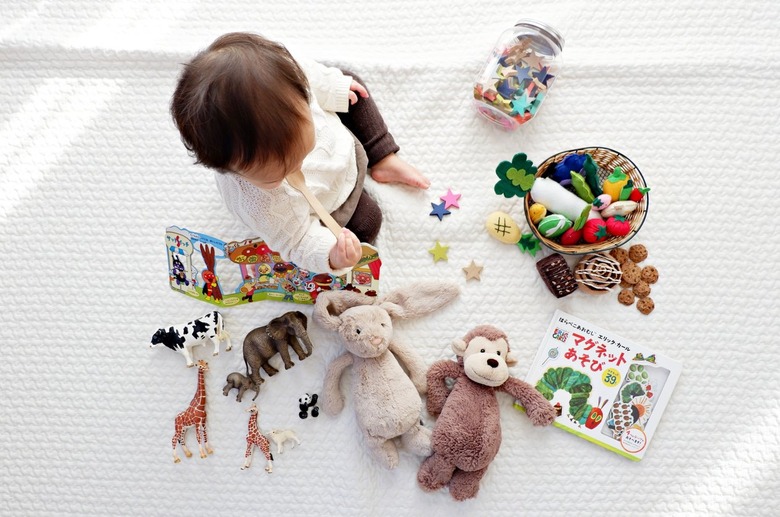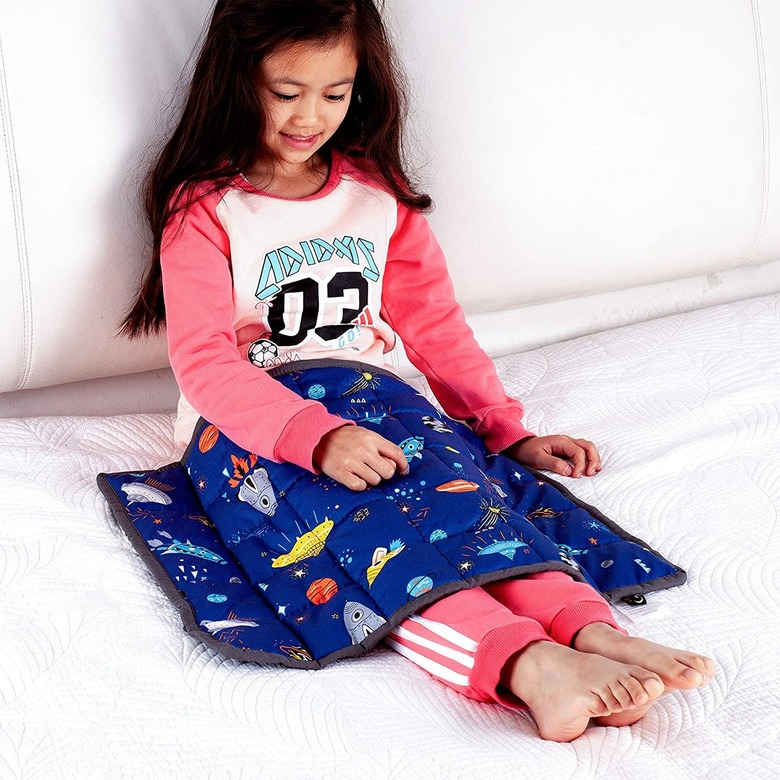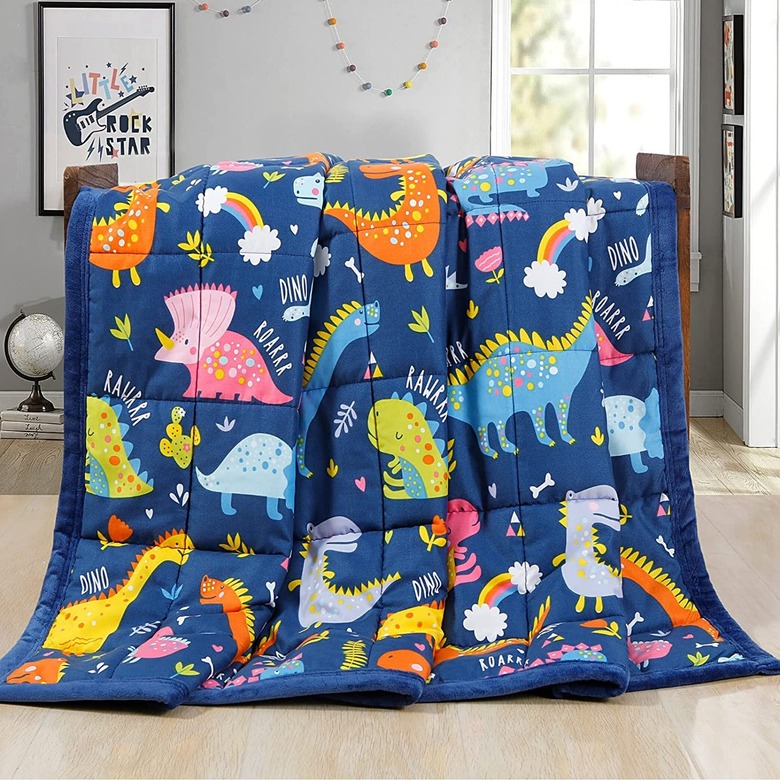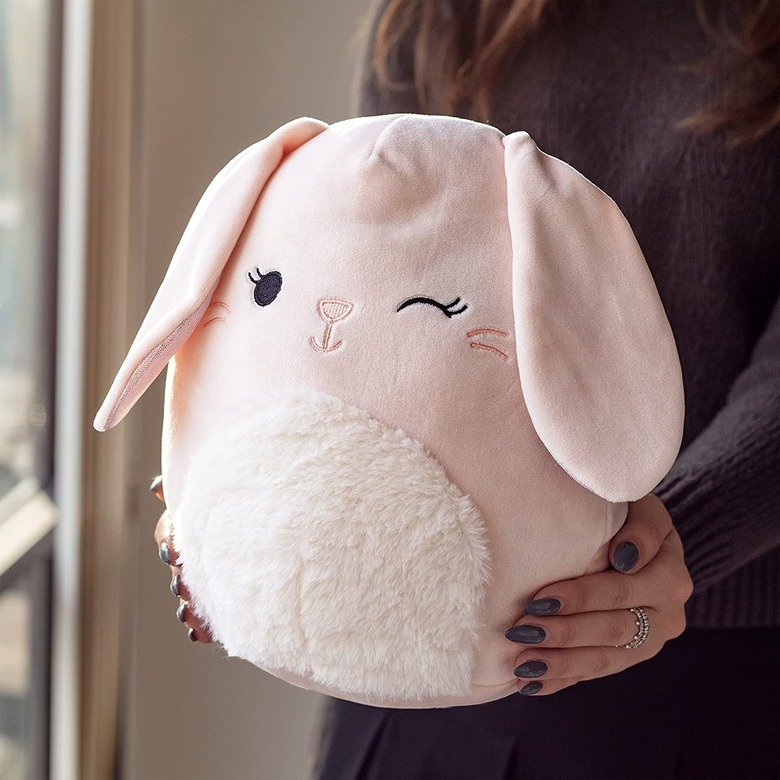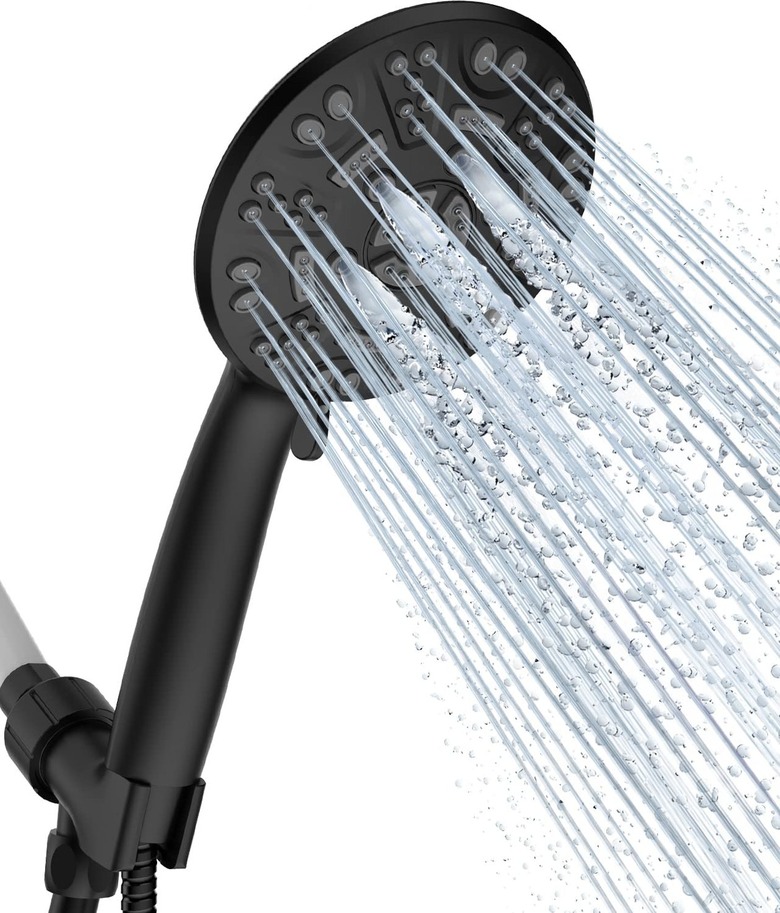17 Items That Can Make Life Easier For Kids With Sensory Processing Disorders
We may receive a commission on purchases made from links.
Being the parent of a neurodivergent child can be a challenge, especially when they aren't at their best because they are receiving too much or too little sensory input. Occupational therapy can help pinpoint your child's sensory needs, but how can you better accommodate them in their home environment? We spoke to experts in the field to find the best solutions to help sensory-sensitive kiddos feel more comfortable in their home — especially in the dining room, bedroom, and bathroom.
The 8 Types of Sensory Input
The 8 Types of Sensory Input
"Sensory processing is the foundation for all learning," Dr. Kay tells Hunker, explaining that it is how people learn about the world around them. While everyone has heard of the five basic human senses — sight (visual), sound (auditory), touch (tactile), taste (gustatory), and smell (olfactory) — sensory processing disorders can involve all eight senses. Yes, you read that right — eight senses. Aside from those five basic senses, we also receive input from the:
- Vestibular system: Sometimes called your "sense
of balance," this system helps to keep you upright and steady. Your vestibular
system detects rotation, acceleration, and deceleration. Individuals who love thrill
rides may crave additional vestibular input, while those who avoid amusement
park rides tend to be sensitive to this type of input. - Proprioceptive system: This system provides
information on the position and movement of your body, letting you know where
you are in space. If you know someone who frequently bumps into walls or knocks
things over, they may have problems interpreting signals from their
proprioceptive system. - Interoceptive system: The least discussed
sensory system, this system provides you with information about your physiological
and physical needs. Children who don't recognize hunger or bathroom cues need
help learning to recognize input from their interoceptive system.
What Kinds of Sensory Issues Exist?
What Kinds of Sensory Issues Exist?
Sensory processing issues involve inaccurately identifying the information received through any of the eight sensory systems, typically recognizing too little or too much stimulation. "Sensory seeking is when someone's sensations are hypoactive, meaning they are underactive, so they seek out more sensory input," explains Dr. Mendel, "and then there's sensory sensitivity, where sensory receptors are hyperactive or overly active. They get overwhelmed very easily and are looking for sensory deprivation."
An individual may be overly aware of stimulations from one type of input and undersensitive to another. For example, a child may be highly sensitive to vestibular input from swings and may need to be pushed gently on swings, but the same child may love wrestling because it provides the tactile and proprioceptive input they crave.
While sensory processing issues most commonly impact those with autism and ADHD, Dr. Kay says the description technically covers anyone who does not accurately process sensory input. She says this could also include those with cerebral palsy, Down syndrome, mental health disorders, and even older adults with dementia.
Some individuals, particularly children, may suffer from sensory processing issues even with no other pathological condition. Strangely, sensory processing disorder, while frequently diagnosed, is not an officially recognized mental health issue under the DSM-5 (Diagnostic and Statistical Manual of Mental Disorders), meaning insurance companies will not cover this condition. "I don't think we fully understand how this all works," admits Dr. Mendel. Parks agrees, noting, "We're still constantly learning so much about sensory input and how it impacts so many aspects of life."
Identifying Your Child’s Needs
Identifying Your Child's Needs
As a parent, your job (ideally with the help of an occupational therapist) is to identify which senses your child has issues with and whether they need more or less input to help regulate them. "Unfortunately," says Parks, "it can take a lot of trial and error [to figure out what works for an individual]." As Dr. Mendel points out, "The same thing does not work for everyone."
For example, even if weighted blankets help many children who need increased proprioceptive input, your child may find them to be too constricting. Dr. Mendel says parents can get an idea of what senses and products to experiment with by trying to "pinpoint the triggers and what seems to set their child off as well as what seems to help the child regulate themself more."
Parks suggests starting with one sense and seeing whether increasing or decreasing that form of input helps. She first recommends addressing sound reduction because "sound is around us all the time, and that's an easy one to cut out." This can be done using noise-canceling headphones.
Dr. Mendel also reminds parents not to spend too much money or time on any specific product, particularly because a child's needs can change over time. "I don't want any parent to feel like there's one tool they have to get in order to be successful," she says. "You don't want to put all your eggs in one basket."
Sensory Products for the Kitchen
Sensory Products for the Kitchen
Getting any kid to sit down for a meal can be challenging, but it's even more difficult if you have a neurodivergent child. Many of these children have difficulty sitting still for a long time. Others are easily overwhelmed by the array of colors, lights, noises, smells, textures, and tastes they experience while eating. "If you're not sensory sensitive, you take all this stuff for granted," says Parks, "but if you are sensitive to any of those, it doesn't take much to get unregulated."
Before buying any special products, reduce the visual and auditory stimuli in the room. Clear the table of anything but food and utensils; dim the lights; and play quiet, calming music or provide your kid with noise-canceling headphones.
Dining Utensils
Some children, especially those with autism, may be quite particular about the specific color, feel, size, or material of their utensils, so let your child guide you in finding what they like and then buy plenty of them so you don't run out. Avoid shopping for special therapeutic utensils unless these have been recommended by an OT (occupational therapist).
Straws
Parks and Dr. Kay recommend having kids use straws, as sucking can provide calming proprioceptive input. To maximize the benefits, use a long silly straw or a regular straw in a thick beverage to make kids work harder to get liquid through the straw, increasing the effect.
Plates
If your child dislikes having their foods touch, invest in plates with divided sections for the different foods.
Foot Rest
Whatever seating arrangement you come up with, Dr. Kay suggests that you ensure your child has somewhere to comfortably place their feet because leaving them dangling can create a feeling of insecurity. An adjustable footrest can help in this regard.
Fidget Toys
If your child is able to better focus when they have fidget toys, easy-to-clean fidgets, like poppers, can make dining at the table easier. Alternatively, you can also try tying exercise bands around the chair legs to allow them to fidget with their feet.
Seating
Dr. Kay says to look at your child's posture and movements while they sit. If they droop like a noodle, they need more postural support, and their chair should have armrests to make them feel comfortable. If they are moving around all the time, try inflatable seat cushions or ball chairs, which will give kids increased vestibular and tactile input to help them focus. Alternatively, a weighted lap mat can provide calming proprioceptive input.
Make Their Bedroom More Relaxing
Make Their Bedroom More Relaxing
Kids spend most of their time at home in their bedroom sleeping, playing with toys, reading, and more. Adding more sensory items to this space can make them feel even more at home, whether they need to chill out or move around. These items can also be added to your living room, playroom, basement, or any other room where your kid hangs out during the day.
Start by creating a calm-down space where your child can relax when overstimulated. Decorate the calm-down space with items that help your kid relax, whether that means pillows, plushies, noise-canceling headphones or Bluetooth headphones, books, or comfy blankets.
Add a Sensory Deprivation Zone
Dr. Mendel says the IKEA PS Lömsk (frequently dubbed the "egg chair") is a great sensory deprivation tool for kids who need to block out as much sensory input as possible, though Dr. Kay warns that some children may find it too confining, causing them to feel claustrophobic. For something more spacious, try a pop-up tent, unused closet space, or a room corner separated by a sheet or curtain.
Beanbag Chairs
Whether you have a child who never slows down or one who needs a place to chill, a beanbag chair is a great option that provides tactile and proprioceptive input. For kids who like to crash into the walls, Dr. Mendel suggests putting a beanbag chair in the corner so they have a safe place to land. She says these chairs can also be good for kids to punch or jump onto, or a child can put it on themselves in place of a weighted blanket.
When buying a beanbag chair, Dr. Kay advises shopping with your child to find one they like, as some chairs keep their shape better and don't let kids sink in as far as others. While some kids enjoy feeling enveloped by these chairs, others feel trapped when they sink in too deep.
Weighted Blankets
Many children with sensory issues, especially those with autism and ADHD, have difficulty falling asleep. Weighted blankets provide calming proprioceptive input, but unfortunately, they are not for everyone, as some people find them too stifling and uncomfortable. Dr. Mendel advises borrowing a weighted blanket or buying a used or inexpensive one to see if your child likes the feeling before investing in this pricey product.
Experts advise buying a weighted blanket that weighs between 10% and 15% of the user's weight. While adults may prefer something heavier than the recommended weight, stay under the maximum recommended weight when shopping for your kids. Additionally, avoid using a weighted blanket on a child under 3 years of age due to the risk of strangling or suffocation.
Cozy Sheets
When it comes to sheets, Dr. Kay suggests sensory-friendly materials, such as soft flannel or jersey. If your child likes the tight squeeze of a weighted blanket but doesn't like the heat or weight, consider using compression sheets.
Sensory-Friendly Plushies
Dr. Mendel says Squishmallows are great for kids to cuddle in bed or in their calm-down space because they are squeezable and have soft textures that many kids enjoy feeling on their face.
Reduce Bathroom Battles
Reduce Bathroom Battles
Getting neurotypical kids to bathe and brush their teeth can be challenging enough, but these tasks can seem nearly impossible when your child has sensory issues. To make bathtime and toothbrushing easier, start by identifying what could be bothering your child about their time in the bathroom. Common causes of sensory overload in the bathroom include bright lights, the sound of the tub filling, the temperature of the water, the smell of the soap, the washcloth texture, and the feeling of water from the shower.
Once you've recognized the cause of your child's discomfort, you can start addressing it. You might try using dimmer bulbs in the light fixtures, filling the bathtub before your child gets in the room, or letting your child use warm water when they brush.
For some kids, just being washed is the problem. While you'll never be able to avoid this, you might be able to make bathtime bearable by adding a few distractions. Try playing calming music that your child likes on a bathroom-friendly Bluetooth speaker and incorporating a few fun bath toys. Dr. Kay recommends sorting toys to keep their mind busy while you wash their body, but you can also try waterproof fidgets, like poppers. If your kid is an artist, encourage them to draw on the tub walls with bathtub crayons or fingerpaint soap.
Soaps and Shampoos
Experiment with the types of bath products you use. While many kids like bubble baths and fruity shampoos, your child might prefer clear bathwater and fragrance-free soap and shampoo.
Washcloth Alternatives
If your washcloth is too rough, try a microfiber alternative or consider using a loofah, a soft scrub brush, a sponge, or even just your hand.
Showerheads
For kids who don't like the way the shower feels, try using a showerhead with multiple settings to see if a harder or softer drip pattern might make things easier.
Toothbrushes
Dr. Kay suggests using an electric toothbrush for kids with a sensitive mouth since the vibrations provide calming proprioceptive input.
Toothpastes
Children who have taste sensitivity often call standard mint toothpaste too "spicy," so for these children, Dr. Kay recommends looking for organic toothpastes, as they are the mildest.
Hourglasses
Dr. Kay also advises parents to put an hourglass by the sink to help ensure their kids brush long enough, as she says that for most people, "if they know how long they have to do something, they can last through it." Additionally, watching the sand run through an hourglass is a calming visual stimulus.
